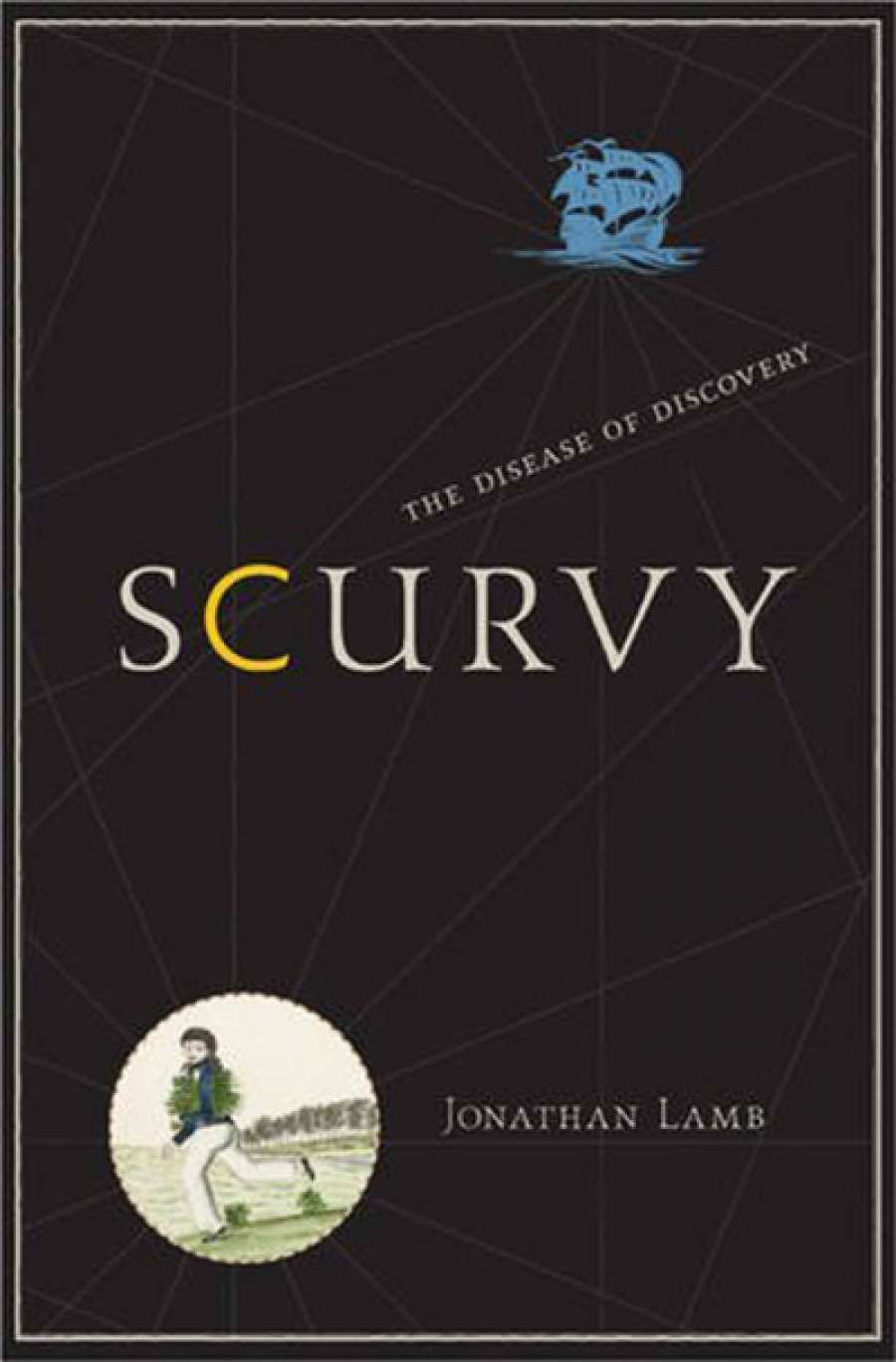
- Free Article: No
- Contents Category: History
- Custom Article Title: Alan Atkinson reviews 'Scurvy: The disease of discovery' by Jonathan Lamb
- Book 1 Title: Scurvy
- Book 1 Subtitle: The disease of discovery
- Book 1 Biblio: Princeton University Press (Footprint), $66 hb, 328 pp, 9780691147826
The Australian historian cannot help being struck especially with Lamb’s penultimate chapter, entitled ‘Australia’ and taking up more than a fifth of the book. Here the author proposes that endemic scurvy played a vital part in shaping creative imagination in colonial Australia. So, he says, ‘scurvy and its satellite formations provided an edge of creative fiction between the evolution of the convict system and what was to end up as the culture of the new colony’. It is not entirely clear what this sentence means, and the same can be said for the argument it summarises. But clearly the argument turns on a single factual issue, the prevalance of scurvy in colonial life, and of this Lamb has no doubt. He declares that the First Fleet, arriving in 1788, initiated ‘the most inveterate outbreak of scurvy anywhere and at any time’, which ‘afflicted the settlements in Port Jackson, Tasmania and the penal outposts of the new colony of Australia for upwards of forty years’.
This is a remarkably bold statement, and it is at odds with several generations of historical scholarship in Australia. It has to be said that Lamb’s understanding of the British colonies on this continent lacks crucial discrimination as to both place and time. He tends to confuse the penal settlements with the white population as a whole, and he tends to confuse the conditions of the first years, and even the first months, with the experience of decades.
So we are told that from first settlement through the 1830s ‘scurvy was endemic in Tasmania – at Macquarie Harbour and Port Arthur – and in settlements on the northern coasts – Moreton Bay, Melville Island, and Port Raffles, as well as rural districts remote from coastal settlements’. Again, citing the Tasmanian scholar Saxby Pridmore (1983), Lamb states that ‘scurvy was the greatest cause of sickness in Tasmania for the first four decades of settlement’. In fact, his source is much less expansive. ‘Scurvy’, Pridmore says, ‘was the most important disease of the early months, but within a year their settler’s gardens were successful, leaving diarrhoea and influenza as the prevailing diseases.’ In 1829 we hear of ‘[e]very kind of English fruit ... in luscious abundance’ (Augustus Prinsep, in Hobart).
As for the mainland, the reference to Melville Island, Port Raffles (should be Fort Wellington), Moreton Bay, and remote rural districts is just as problematic. And yet, it leads to the suggestion that New South Wales as a whole was ‘a pump for scurvy – sucking it in, seasoning it, and sending it out again ... [in] a putrid current’. The cause was defective diet on a massive scale, and that in turn was due, Lamb says, to ‘the lawless violence of a delinquent governing class ... destitute of any active principle of human community and social good’.
 Image from the journal of Henry Walsh Mahon showing the effects of scurvy, from his time aboard HM Convict Ship Barrosa, 1841
Image from the journal of Henry Walsh Mahon showing the effects of scurvy, from his time aboard HM Convict Ship Barrosa, 1841
(The National Archives UK, Wikimedia Commons)
It is not explained how the diet of a population which in 1836 numbered 70,000, two-thirds of them free, could have been so thoroughly controlled, or why a governing class keen to live well itself should have wanted to starve its workforce. In fact, as in Hobart, gardens and orchards were common from the early years – the government printer in Sydney issued a garden guide for settlers in 1806 – and even convict labourers were always much better fed than the poor in England. As for the incidence of scurvy in New South Wales, I quote the medical historian Milton Lewis (Medical Journal of Australia, 2014). In 1788–1792 [at Port Jackson], mortality was very high, due mainly to dysentery, typhus and typhoid ... abetted by malnutrition and scurvy. Even at the beginning, then, scurvy was a secondary problem, and in Lewis’s account it thereafter drops from view. So, by the 1820s and 1830s, ‘dysentery was the most prevalent disease, but rheumatism, venereal disease (VD), “dropsy” (oedema), ophthalmia and erysipelas were also common’.
One large question lurks beneath the surface of this book. What does a more detailed understanding of scurvy really add to our appreciation of literature as literature? I did not know that ‘The Rime of the Ancient Mariner’ was about physical and mental degeneration among seamen. But I do not need to know it. From an historical point of view it is a triviality, and from a literary point of view it is a banal distraction. Again, despite its beauty, it is the lack of discriminating argument, and of properly organised priorities, which defines this book in the end.


Comments powered by CComment